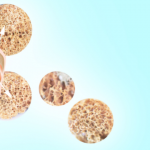Vitiligo is a long-term condition where pale white patches develop on the skin, caused by the lack of melanin, which is the pigment in the skin. It occurs when cells that produce melanin die or stop functioning.
What causes Vitiligo?
- An autoimmune condition: The immune system mistakes healthy cells (melanocytes) as foreign invaders like bacteria that can cause harm to the body.
- Genetic changes: A genetic mutation or a change to your body’s DNA can affect the melanocyte’s function.
- Stress: The amount of pigment your melanocyte cells produce may change if you experience frequent stress, especially after an injury.
- Environmental triggers: Factors like ultraviolet radiation and toxic chemical exposure can affect how your melanocyte cell functions.
Vitiligo symptoms can be mild or severe; However, some people with Vitiligo experience itchy skin before depigmentation starts.
What are the symptoms of Vitiligo?
- White patches on the skin.
- Premature graying or whitening of the hair, eyebrows, facial hair, or eyelashes.
- Loss of pigment in the mucous membranes, including the inner lining of the nose and lips.
Vitiligo usually starts with small white macules or patches that may gradually spread over the body. Vitiligo typically begins on the hands, forearms, feet, and face but can develop on any part of the body, including the mucous membranes, the eyes, and inner ears. However, the specific areas affected may vary depending on the type of Vitiligo.
What are the types of Vitiligo?
- Generalized: This is the most common type of Vitiligo that causes macules to appear in various places on the body.
- Segmental: This type only affects one side of the body or one area, such as the hands or face.
- Mucosal: Mucosal Vitiligo affects the mucous membranes of the mouth and genitals.
- Focal Vitiligo: This is a rare type where the macules develop in a small area; it happens when the discoloration stays in one spot and doesn’t spread.
- Trichome: This type causes a bullseye with a white or colorless center; Trichome is when there is an area of heavy discoloration, followed by an area of lighter discoloration, followed by regular-color skin.
- Universal: This rare type of Vitiligo causes more than 80% of the skin to be discolored.
Who is likely to get affected by Vitiligo?
Vitiligo affects all races, ages, and sexes equally. However, people with certain autoimmune conditions might be at a higher risk of developing Vitiligo; autoimmune conditions such as:
- Addison’s disease.
- Anemia.
- Diabetes (Type 1).
- Lupus.
- Psoriasis.
- Rheumatoid arthritis.
- Thyroid disease.
- Alopecia areata, or baldness.
- Scleroderma is a disorder of the connective tissue of the body.
Tips to prevent Vitiligo from getting worse?
- Protect your skin from the sun. Skin that has lost its natural color tends to sunburn quickly; A bad sunburn can worsen Vitiligo.
- Do not use a tanning bed or sun lamp. These are not safe alternatives to the sun. These, too, can burn skin that has lost pigment and worsen Vitiligo.
- Avoid cuts, scrapes, and burns. For some people, a skin injury triggers new spots or patches. Do your best to avoid injuring your skin.
- Use camouflage makeup, self-tanner, or skin dye to add color to the skin. These products can add color safely.
- Support your immune system with a healthy lifestyle. Vitiligo is an autoimmune disease, meaning that it attacks healthy cells.
- Take care of your mental health.
Consult an Intercare doctor if areas of your skin, hair, or mucous membranes lose color. Vitiligo has no cure, but treatment might stop or slow the discoloring process and return some color to your skin.
Sources












